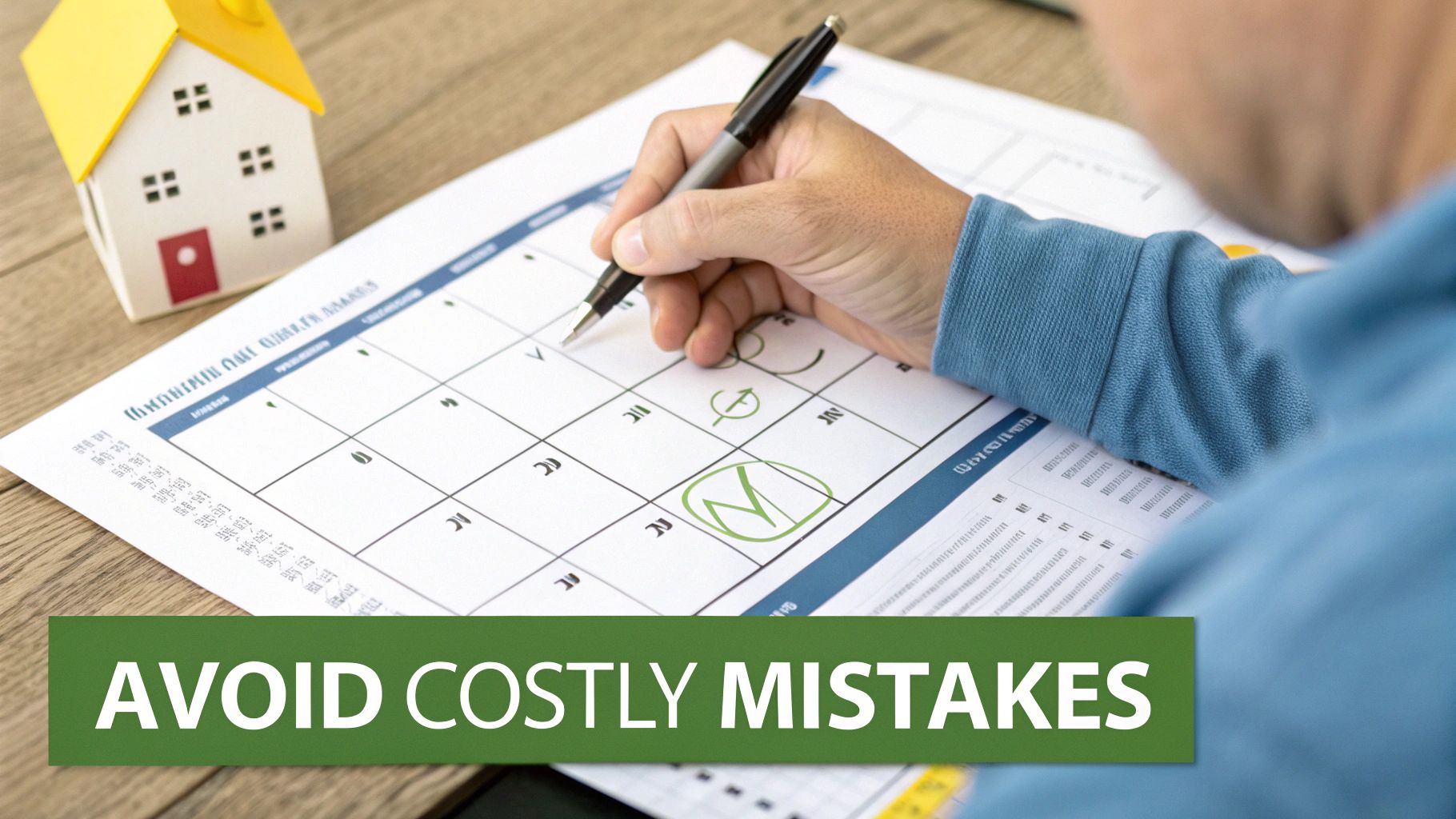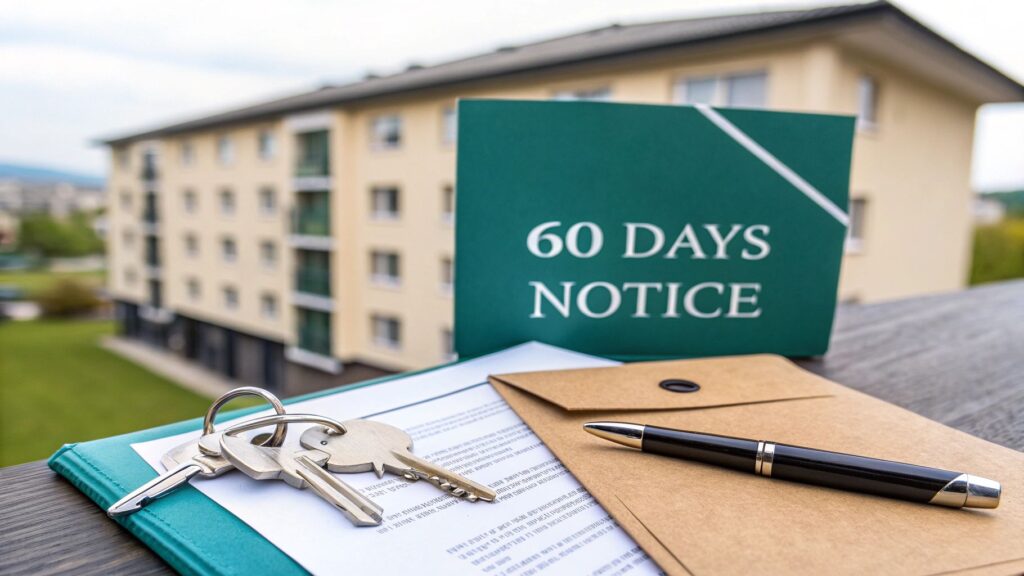So, what exactly is a 60 days notice letter? It’s a formal, written notice you give your landlord that you'll be moving out, officially kicking off the 60-day countdown to the end of your tenancy. This letter is more than just a heads-up; it's your legal proof that you've followed the rules of your lease.
Getting this right is your best bet for protecting your security deposit and keeping your rental history clean.
Why This Letter Is Such a Big Deal
Staring down a blank page to write your notice can feel like one last hurdle before the chaos of moving. But trust me, this isn't a step you want to rush. This simple document is a crucial piece of the puzzle that protects both your money and your future renting prospects.
A clear, professional 60 days notice is your official record. It prevents any "he said, she said" arguments about when you gave notice, ensuring you've met your legal obligations. It’s the key to getting your full security deposit back without a fight and securing a glowing reference from your landlord—something that can make or break your application for your next place.
Think of it less as a goodbye letter and more as a professional tool for a smooth, drama-free exit.

Beyond Just Giving Notice
This letter officially closes the chapter on your current lease. But what if life throws you a curveball and you need to leave earlier than planned? If you can't ride out the full term, it's worth looking into other avenues. For instance, understanding the ins and outs of an apartment lease buyout can offer a clean break. It usually involves a fee, but it can save you from being on the hook for months of rent on an empty apartment.
Your notice letter serves a few critical functions:
- It Creates a Paper Trail: This is your dated, written proof that you provided notice exactly as your lease requires.
- It Sets Clear Expectations: Your landlord knows your exact move-out date, allowing them to start scheduling showings and find a new tenant without any guesswork.
- It Helps Get Your Deposit Back: By including your forwarding address, you’re telling your landlord exactly where to mail your security deposit check.
A well-crafted notice isn't just a courtesy—it's your first line of defense against any financial snags or misunderstandings during your move. It’s a small document that carries significant legal and financial weight.
What Every Notice to Vacate Must Include

Before you even think about putting pen to paper, remember this: your notice to vacate isn't just a friendly note. It's a formal, legally significant document.
Missing a single key detail could invalidate the whole thing. That might mean you're on the hook for another month's rent, creating a major headache you don't need during a move. Let’s make sure that doesn't happen.
The Non-Negotiable Basics
Every notice letter needs to start with the fundamentals to make it official. First up is the current date. This is what kicks off your 60-day countdown, so get it right.
Next, clearly state your full name and your complete current address, unit number and all. Just below that, list the full name of your landlord or property management company and their official business address. This seems obvious, but it formally establishes who is sending the notice and who is receiving it, leaving no room for confusion.
Your intention to move must be crystal clear. This is no time for soft language. Get straight to the point with a sentence like, "This letter serves as my official notice of intent to vacate the property…"
Pro Tip: Don't just say you're leaving "in 60 days." That's too vague. You must name the specific date you'll be handing over the keys, like "…and will be vacating on or before October 31, 2024." This eliminates any ambiguity about your final day of tenancy.
The Details That Protect You
Here's a crucial tip many renters overlook: always include your forwarding address. This is your best tool for getting your security deposit back promptly. By providing it in your notice, you’re legally telling the landlord exactly where to mail your refund and any itemized list of deductions. Skipping this step often leads to frustrating delays.
Finally, your lease agreement is your rulebook. Before you send anything, pull it out and give it a thorough read. Your lease might specify exactly how the notice needs to be delivered—some require certified mail to be valid. Digging into these details now can save you a world of trouble later. You can find more smart tips for navigating apartment lease agreements to help you understand all the fine print.
To make it even easier, I've put together a quick-reference table with all the essential information your notice letter absolutely must have.
Essential Information for Your Notice Letter
This table breaks down the mandatory components. Think of it as your final checklist before you sign, seal, and deliver your notice.
| Component | Purpose | Example |
|---|---|---|
| Current Date | Officially starts the 60-day notice period. | "June 1, 2024" |
| Your Full Name & Address | Identifies you as the tenant and specifies the property. | "Jane Smith, 123 Main St, Apt 4B, Anytown, ST 12345" |
| Landlord's Name & Address | Formally identifies the recipient of the notice. | "ABC Property Management, 456 Business Ave, Anytown, ST 12345" |
| Statement of Intent | Unambiguously declares your plan to move out. | "This letter is my official notice to vacate the premises." |
| Specific Move-Out Date | Sets the exact final day of your lease term. | "My final day of tenancy will be July 31, 2024." |
| Forwarding Address | Ensures the timely and proper return of your security deposit. | "Please forward my security deposit to: 789 New Home Rd, New City, ST 67890." |
| Your Signature | Makes the document legally valid and binding. | Your handwritten or legally accepted digital signature. |
Nailing these components ensures your notice is professional, legally sound, and helps pave the way for a smooth move-out process.
How to Write Your 60 Days Notice Letter

Alright, you've got your checklist and you know what needs to be said. Now, let's turn that into a professional letter. Don't worry, this isn't about sounding like a lawyer. The best notice letters are clear, direct, and respectful. You’re simply creating a formal record that you're upholding your end of the lease agreement.
I find it easiest to break the letter down into three chunks: the opening, the essential details, and the closing. Each part has a specific job to do, and together they create an effective, no-fuss notice.
Crafting a Clear and Direct Opening
First things first, treat this like a standard business letter. Put your name, current address (with the unit number!), and the date at the very top. Then, add your landlord or property management company's full name and address just below. This simple formatting makes it instantly clear who the letter is from and who it's for.
Now for the opening line. Get straight to the point. There’s no need for a long-winded intro.
- For example: "Please accept this letter as my official 60-day notice of my intent to vacate the apartment at [Your Full Address, including Unit #]. As per my lease agreement, my final day of tenancy will be [Your Specific Move-Out Date]."
See? No ambiguity. You've clearly stated your purpose, referenced the 60-day requirement, and locked in your move-out date. This is exactly what your landlord needs to see.
A quick pro-tip: Keep your tone neutral and professional. Even if you've had a less-than-perfect experience, this letter isn't the place to air grievances. The goal here is a smooth, drama-free exit that gets your security deposit back.
Including Key Logistical Details
The middle of your letter is all about the practical stuff. This is where you'll lay out the information your landlord needs to manage your move-out and, most importantly, handle your security deposit. Think of it as being helpful and proactive.
The most critical piece of information here is your forwarding address. State it plainly. This is where your landlord is legally required to send your security deposit refund or a letter explaining any deductions. Forgetting this can cause major delays.
Next, I always recommend bringing up the move-out inspection. You can simply ask to schedule the final walkthrough. Doing this shows you're committed to leaving the unit in good shape and gives you a chance to be there when they assess the condition. It's your best defense against unfair deposit deductions.
You might also want to add a quick line about how you'll return the keys, parking passes, or any key fobs. Mentioning these small details shows you're on top of things and makes the final handover that much smoother for everyone involved.
Grab-and-Go 60-Day Notice Templates
To make this whole process a bit easier, I’ve put together a couple of battle-tested templates you can swipe and adapt. No need to stare at a blank page.
First up is a simple, straightforward notice. It’s perfect for most standard situations where you just need to get the job done. It's clean, direct, and covers all the legal must-haves without any unnecessary jargon.
The second one is a bit more detailed. It’s built for those times when you need to coordinate things a little more, like locking in a time for the final inspection or mentioning a specific clause from your lease.
Just pick the one that feels right for your situation, plug in your details, and you'll have a professional 60-day notice letter ready in no time. Think of these as a solid starting point to build from.
The Standard Notice Template
This is your go-to for a no-fuss move-out. It’s perfect when your lease is ending naturally and you’re simply giving the required heads-up.
[Your Full Name]
[Your Current Address, Including Unit Number]
[City, State, Zip Code][Date]
[Landlord or Property Manager's Name]
[Landlord or Property Management Company's Address]
[City, State, Zip Code]Subject: Notice to Vacate – [Your Address, Unit #]
Dear [Landlord/Property Manager's Name],
Please accept this letter as my official 60-day notice to vacate the property located at [Your Full Address, Unit #]. As required by my lease agreement, my final day of tenancy will be [Your Move-Out Date].
I will make sure the apartment is clean and in good condition before I leave. Please let me know what day and time works best to schedule a final walkthrough.
You can forward my security deposit to my new address:
[Your Forwarding Address]
[City, State, Zip Code]Thank you for your attention to this.
Sincerely,
[Your Signature]
[Your Printed Name]
[Your Phone Number]
[Your Email Address]
The Detailed Notice Template
Reach for this template when you need to be more specific. Maybe you're breaking your lease and need to reference an early termination clause, or you want to proactively schedule the walkthrough inspection. This version adds an extra layer of clarity to get everyone on the same page.
[Your Full Name]
[Your Current Address, Including Unit Number]
[City, State, Zip Code][Date]
[Landlord or Property Manager's Name]
[Landlord or Property Management Company's Address]
[City, State, Zip Code]Subject: Formal 60-Day Notice of Intent to Vacate – [Your Address, Unit #]
Dear [Landlord/Property Manager's Name],
This letter is my formal 60-day notice that I will be terminating my lease and vacating the premises at [Your Full Address, Unit #]. My final day of occupancy will be [Your Move-Out Date], in full compliance with my lease.
To ensure a smooth transition, I would like to schedule the final move-out inspection for the morning of [Your Move-Out Date]. I will be prepared to return all keys, parking passes, and fobs to you at that time.
Please send my security deposit of $[Amount] to my forwarding address below:
[Your Forwarding Address]
[City, State, Zip Code]Thank you for your cooperation.
Best regards,
[Your Signature]
[Your Printed Name]
[Your Phone Number]
[Your Email Address]
Common Mistakes That Can Cost You

Even with a perfectly written 60-day notice letter, a few simple mistakes in how you handle it can turn a smooth move-out into a financial headache. I’ve seen tenants lose part of their security deposit over slip-ups that are incredibly easy to avoid. Don't let that be you.
One of the biggest tripwires is ignoring your lease's specific instructions for giving notice. Your landlord might require certified mail for it to be legally binding. If that's the case, an email won't cut it, even if they reply. Sending it the wrong way could technically invalidate your notice.
Miscalculations and Vague Language
Another common pitfall is getting the timing wrong. When you calculate the 60-day window, you need to count full calendar days starting from the day the landlord actually receives the letter, not just the day you send it. Miscounting by even a single day could leave you on the hook for prorated rent you hadn't planned on paying.
Vague language is just as dangerous. A statement like, "I'll be moving out in about 60 days," is a recipe for confusion. It doesn't give a clear end date for your tenancy, which can lead to disputes down the road.
Always state a specific, final date of occupancy. This single detail prevents arguments and helps your landlord start planning, which goes a long way toward an amicable departure.
And finally, always keep a copy of the signed notice for your records. This is your proof. If your landlord claims they never got it, your copy (along with a certified mail receipt) is your only defense. These small missteps are often why tenants have trouble getting their money back; it's worth understanding exactly what a security deposit is and how to protect it.
By sidestepping these common errors, you can make sure your move-out is as seamless and stress-free as possible, protecting both your finances and your rental history.
Common Questions About Giving Your Notice
Even when you're excited about moving, the logistics can bring up some last-minute questions. It’s always a good idea to get these sorted out before you officially hand in your 60-day notice.
What Happens If I Don't Give a Full 60 Days' Notice?
This is a common slip-up, and it almost always has a financial catch. If you miss that 60-day window, your lease doesn't just end. It usually rolls over into a month-to-month agreement.
The problem? That month-to-month rate is often significantly higher than what you were paying. You'll likely find yourself on the hook for rent until the full 60-day period is up, potentially costing you an extra month's payment you didn't budget for.
Can I Just Email My Notice Letter?
Email feels quick and easy, but it might not be the official method your landlord requires. Before you hit "send," pull out your lease agreement and read the fine print.
Many landlords and management companies specifically require notice to be sent via certified mail. This creates a legal paper trail with a delivery receipt, protecting both you and them. If you do opt for email, at the very least, follow up and request a written confirmation that they received it. Don't just assume it was seen.
A crucial reminder: Your security deposit is not a substitute for your last month's rent. You are legally required to pay for your final month in full. The deposit is held separately and is only meant to cover potential damages beyond normal wear and tear after you've moved out.
If your move involves more than just a trip across town, you'll find that planning becomes much more complex. This expert guide on how to prepare for moving out of state is a great resource to help you manage the bigger picture.
Ready for a seamless move in Boca Raton? Explore the beautiful, conveniently located apartments at Cynthia Gardens. Find your perfect new home today at https://cynthiagardens.com.
